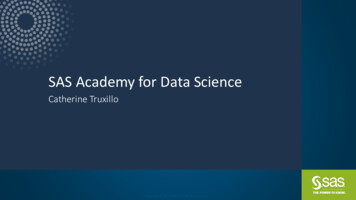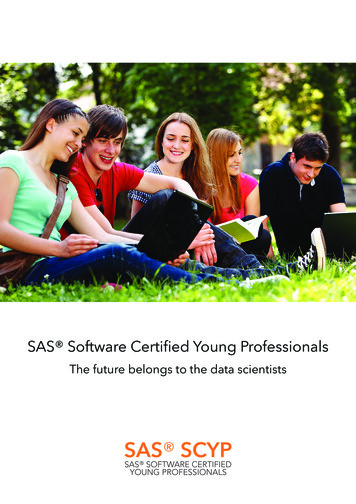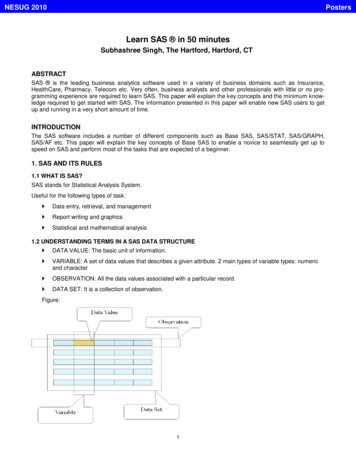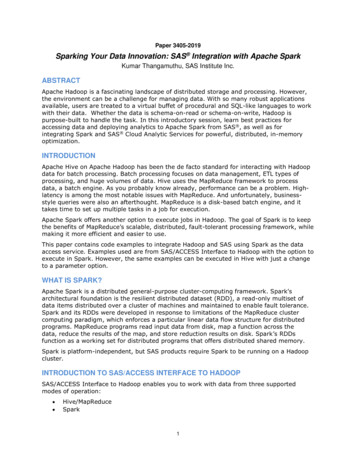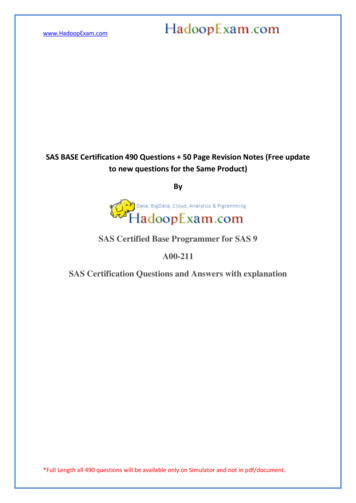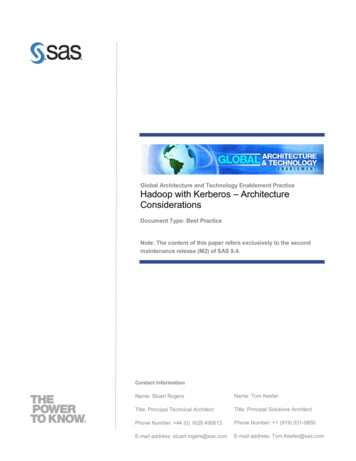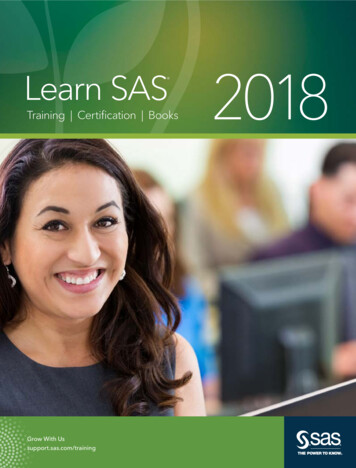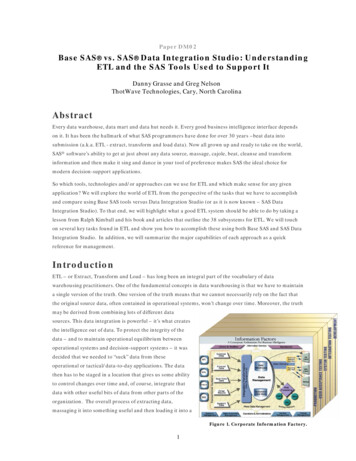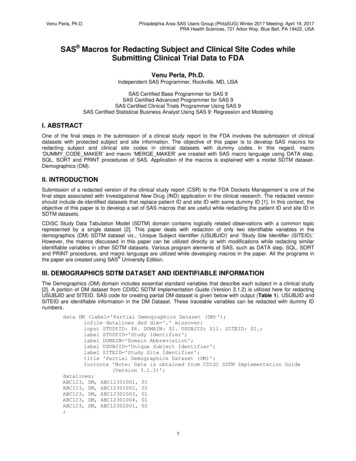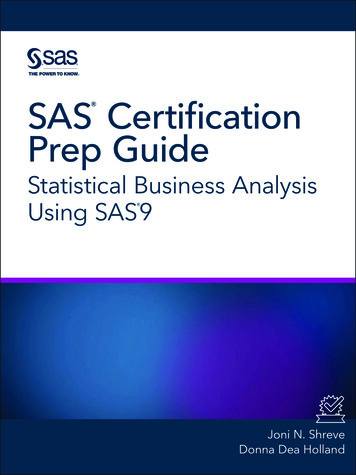
Transcription
The correct bibliographic citation for this manual is as follows: Shreve, Joni N. and Donna Dea Holland . 2018. SAS Certification PrepGuide: Statistical Business Analysis Using SAS 9. Cary, NC: SAS Institute Inc.SAS Certification Prep Guide: Statistical Business Analysis Using SAS 9Copyright 2018, SAS Institute Inc., Cary, NC, USA978-1-62960-381-0 (Hardcopy)978-1-63526-352-7 (Web PDF)978-1-63526-350-3 (epub)978-1-63526-351-0 (mobi)All Rights Reserved. Produced in the United States of America.For a hard-copy book: No part of this publication may be reproduced, stored in a retrieval system, or transmitted, in any form or by anymeans, electronic, mechanical, photocopying, or otherwise, without the prior written permission of the publisher, SAS Institute Inc.For a web download or e-book: Your use of this publication shall be governed by the terms established by the vendor at the time youacquire this publication.The scanning, uploading, and distribution of this book via the Internet or any other means without the permission of the publisher is illegaland punishable by law. Please purchase only authorized electronic editions and do not participate in or encourage electronic piracy ofcopyrighted materials. Your support of others’ rights is appreciated.U.S. Government License Rights; Restricted Rights: The Software and its documentation is commercial computer software developed atprivate expense and is provided with RESTRICTED RIGHTS to the United States Government. Use, duplication, or disclosure of theSoftware by the United States Government is subjectto the license terms of this Agreement pursuant to, as applicable, FAR 12.212, DFAR 227.7202-1(a), DFAR 227.7202-3(a), and DFAR227.7202-4, and, to the extent required under U.S. federal law, the minimum restricted rights as set out in FAR 52.227-19 (DEC 2007). IfFAR 52.227-19 is applicable, this provision serves as notice under clause (c) thereof and no other notice is required to be affixed to theSoftware or documentation. The Government’s rights in Software and documentation shall be only those set forth in this Agreement.SAS Institute Inc., SAS Campus Drive, Cary, NC 27513-2414December 2018SAS and all other SAS Institute Inc. product or service names are registered trademarks or trademarks of SAS Institute Inc. in the USAand other countries. indicates USA registration.Other brand and product names are trademarks of their respective companies.SAS software may be provided with certain third-party software, including but not limited to open-source software, which is licensed underits applicable third-party software license agreement. For license information about third-party software distributed with SAS software,refer to http://support.sas.com/thirdpartylicenses.
ContentsAbout this Book . vChapter 1: Statistics and Making Sense of Our World .1Introduction .1What Is Statistics? .2Variable Types and SAS Data Types .3The Data Analytics Process .4Getting Started with SAS.9Key Terms .12Chapter 2: Summarizing Your Data with Descriptive Statistics .13Introduction .13Measures of Center .14Measures of Variation .16Measures of Shape .18Other Descriptive Measures .21The MEANS Procedure .22Key Terms .49Chapter Quiz .50Chapter 3: Data Visualization . 53Introduction .53View and Interpret Categorical Data.54View and Interpret Numeric Data .64Visual Analyses Using the SGPLOT Procedure .76Key Terms .85Chapter Quiz .86Chapter 4: The Normal Distribution and Introduction to Inferential Statistics .89Introduction .89Continuous Random Variables .90The Sampling Distribution of the Mean .100Introduction to Hypothesis Testing .107Hypothesis Testing for the Population Mean (σ Known) .111Hypothesis Testing for the Population Mean (σ Unknown) .118Key Terms .124Chapter Quiz .125Chapter 5: Analysis of Categorical Variables . 127Introduction .127Testing the Independence of Two Categorical Variables .127Measuring the Strength of Association between Two Categorical Variables .132Key Terms .137Chapter Quiz .138Chapter 6: Two-Sample t-Test . 141Introduction .141Independent Samples .141Paired Samples .151
vi ContentsKey Terms . 155Chapter Quiz . 156Chapter 7: Analysis of Variance (ANOVA) . 159Introduction. 159One-Factor Analysis of Variance . 160The Randomized Block Design . 177Two-Factor Analysis of Variance . 186Key Terms . 195Chapter Quiz . 195Chapter 8: Preparing the Input Variables for Prediction . 199Introduction. 199Missing Values . 200Categorical Input Variables . 205Variable Clustering . 215Variable Screening . 225Key Terms . 235Chapter Quiz . 235Chapter 9: Linear Regression Analysis. 241Introduction. 241Exploring the Relationship between Two Continuous Variables. 242Simple Linear Regression . 250Multiple Linear Regression . 258Variable Selection Using the REG and GLMSELECT Procedures . 269Assessing the Validity of Results Using Regression Diagnostics . 292Concluding Remarks . 311Key Terms . 312Chapter Quiz . 313Chapter 10: Logistic Regression Analysis . 317Introduction. 317The Logistic Regression Model . 318Logistic Regression with a Categorical Predictor . 329The Multiple Logistic Regression Model . 334Scoring New Data . 357Key Terms . 363Chapter Quiz . 363Chapter 11: Measure of Model Performance . 367Introduction. 367Preparation for the Modeling Phase . 368Assessing Classifier Performance . 372Adjustment to Performance Estimates When Oversampling Rare Events . 387The Use of Decision Theory for Model Selection . 395Key Terms . 400Chapter Quiz . 401References . 405
About This BookWhat Does This Book Cover?The SAS Certification Prep Guide: Statistical Business Analysis Using SAS 9 is written for both new and experiencedSAS programmers intending to take the SAS Certified Statistical Business Analyst Using SAS 9: Regression andModeling exam. This book covers the main topics tested on the exam which include analysis of variance, linear andlogistic regression, preparing inputs for predictive models, and measuring model performance.The authors assume the reader has some experience creating a SAS program consisting of a DATA step andPROCEDURE step, and running that program using any SAS platform. While knowledge of basic descriptive andinferential statistics is helpful, the authors provide several introductory chapters to lay the foundation for understandingthe advanced statistical topics.Requirements and DetailsExam ObjectivesSee the current exam objectives at https://www.sas.com/en atisticalbusiness-analyst.html. Exam objectives are subject to change.Take a Practice ExamPractice exams are available for purchase through SAS and Pearson VUE. For more information about practice exams,see https://www.sas.com/en .Registering for the ExamTo register for the official SAS Certified Statistical Business Analyst Using SAS 9: Regression and Modeling exam,see the SAS Global Certification website at www.sas.com/certify (https://www.sas.com/en us/ certification.html).Syntax ConventionsIn this book, SAS syntax looks like this example:DATA output-SAS-data-set(DROP variables(s) KEEP variables(s));SET SAS-data-set options ;BY variable(s)RUN;Here are the conventions used in the example: DATA, DROP , KEEP , SET, BY, and RUN are in uppercase bold because they must be spelled as shown. output-SAS-data-set, variable(s), SAS-data-set, and options are in italics because each represents a value thatyou supply. options is enclosed in angle brackets because it is optional syntax. DROP and KEEP are separated by a vertical bar ( ) to indicate that they are mutually exclusive.The example syntax shown in this book includes only what you need to know in order to prepare for the certificationexam. For complete syntax, see the appropriate SAS reference guide.
viWhat Should You Know about the Examples?This book includes tutorials for you to follow to gain hands-on experience with SAS.Software Used to Develop the Book's ContentTo complete examples in this book, you must have access to Base SAS, SAS Enterprise Guide, or SAS Studio.Example Code and DataYou can access all example code and data sets for this book by linking to the author pages athttps://support.sas.com/shreve or https://support.sas.com/dholland. There you will also find directions on how to save thedata sets to your computer to ensure that the example code runs successfully. The author pages also include appendiceswhich contain detailed descriptions of the two main data sets used throughout this book: (1) the Diabetic CareManagement Case, and (2) the Ames Housing Case.You can also refer to the section “Getting Started with SAS” in Chapter 1, "Statistics and Making Sense of Our World,”for a general description of the two main data sets, a list of all data sets by chapter, and a sample program whichillustrates how to access the data within the SAS environment.SAS University EditionThis book is compatible with SAS University Edition. In order to download SAS University Edition, go tohttps://www.sas.com/en us/software/university-edition.html.Where Are the Exercise Solutions?Exercise solutions and Appendices referenced in the book are available on the author pages athttps://support.sas.com/shreve or https://support.sas.com/dholland.We Want to Hear from YouDo you have questions about a SAS Press book that you are reading? Contact us at saspress@sas.com.SAS Press books are written by SAS Users for SAS Users. Please visit sas.com/books to sign up to requestinformation on how to become a SAS Press author.We welcome your participation in the development of new books and your feedback on SAS Press books that youare using. Please visit sas.com/books to sign up to review a bookLearn about new books and exclusive discounts. Sign up for our new books mailing list today .html.Learn more about these authors by visiting their author pages, where you can download free book excerpts,access example code and data, read the latest reviews, get updates, and .sas.com/dholland
Chapter 1: Statistics and Making Sense of Our WorldIntroduction .1What Is Statistics?.2The Two Branches of Statistics . 2Variable Types and SAS Data Types .3Variable Types. 3SAS Data Types . 3The Data Analytics Process .4Defining the Purpose . 4Data Preparation. 4Analyzing the Data and Roadmap to the Book . 7Conclusions and Interpretation . 8Getting Started with SAS .9Diabetic Care Management Case . 9Ames Housing Case . 9Accessing the Data in the SAS Environment . 10Key Terms .12IntroductionThe goal of this book is to prepare future analysts for the SAS statistical business analysis certification exam. 1 Therefore,the book aims to validate a strong working knowledge of complex statistical analyses, including analysis of variance,linear and logistic regression, and measuring model performance. This chapter covers the basic and fundamentalinformation needed to understand the foundations of those more advanced analyses. We begin by explaining whatstatistics is and providing definitions of terms needed to get started.The chapter continues with a birds-eye view of the data analytics process including defining the purpose, datapreparation, the analysis, conclusions and interpretation. Special consideration is given to the data preparation phase-with such topics as sampling, missing data, data exploration, and outlier detection--in an attempt to stress its importancein the validity of statistical conclusions. Where necessary we refer you to additional sources for further readings.This chapter includes a road map detailing the scope of the statistical analyses covered in this book and how the specificanalyses relate to the purpose. Finally, the chapter closes with a description of the data sets to be used throughout thebook and provides you the first opportunity to access the data using sample SAS code before proceeding to subsequentchapters.In this chapter you will learn about: statistics’ two branches, descriptive statistics and inferential statistics, data mining, and predictive analytics variable types and how SAS distinguishes between numeric and character data types the data analytics process, including defining the purpose, data preparation, analysis, conclusions andinterpretation exploratory analysis versus confirmatory analysis sampling and how it relates to bias selection bias, nonresponse bias, measurement error, confounding variables the importance of data cleaning the role of data cleaning to identify data inconsistencies, to account for missing data, and to create newvariables, dummy codes, and variable transformations terms such as missing completely at random (MCAR), missing at random (MAR), and not missing at random(NMAR), and conditions for imputation data exploration for uncovering interesting patterns, detecting outliers, and variable reduction the roles of variables as either response or predictors the analytics road map used for determining the specific statistical modeling approach based upon the businessquestion, the variable types, and the variable roles
2 SAS Certification Prep Guide: Statistical Business Analysis Using SAS 9 the statistical models to be tested on the certification exam, including two-sample t-tests, analysis of variance(ANOVA), linear regression analysis, and logistic regression analysis the use of the training data set and the validation data set to assess model performance both the Diabetic Care Management Case and the Ames Housing Case to be used throughout the book, theircontents, and the sample SAS code used the read the data and produce an output of contents.What Is Statistics?We see and rely on statistics every day. Statistics can help us understand many aspects of our lives, including the price ofhomes, automobiles, health and life insurance, interest rates, political perceptions, to name a few. Statistics are usedacross many fields of study in academia, marketing, healthcare, treatment regimes, politics, housing, government, privatebusinesses, national security, sports, law enforcement, and NGOs. The extensive reliance on statistics is growing.Statistics drive decisions to solve social problems, guide and build businesses, and develop communities. With thewealth of information available today, business persons need to know how to use statistics efficiently and effectively forbetter decision making. So, what is statistics?Statistics is a science that relies on particular mathematical formulas and software to derive meaningful patterns andextrapolate actionable information from data sets. Statistics involves the use of plots, graphs, tables, and statistical teststo validate hypotheses, but it is more than just these. Statistics is a unique way to use data to make improvements andefficiencies in virtually any business or organization that collects quality data about their customers, services, costs, andpractices.The Two Branches of StatisticsBefore defining the two branches of statistics, it is important to distinguish between a population and a sample. Thepopulation is the universe of all observations for which conclusions are to be made and can consist of people or objects.For example, a population can be made up of customers, patients, products, crimes, or bank transactions. In reality, it isvery rare and sometimes impossible to collect data from the entire population. Therefore, it is more practical to take asample--that is, a subset of the population.There are two branches of statistics, namely descriptive statistics and inferential statistics. Descriptive statistics includesthe collection, cleaning, and summarization of the data set of interest for the purposes of describing various features ofthat data. The features can be in the form of numeric summaries such as means, ranges, or proportions, or visualsummaries such as histograms, pie charts, or bar graphs. These summaries and many more depend upon the types ofvariables collected and will be covered in Chapter 2, “Summarizing Your Data with Descriptive Statistics” and Chapter3, “Data Visualization.”Inferential statistics includes the methods where sample data is used to make predictions or inferences about thecharacteristics of the population of interest. In particular, a summary measure calculated for the sample, referred to as astatistic, is used to estimate a population parameter, the unknown characteristic of the population. Inferential methodsdepend upon both the types of variables and the specific questions to be answered and will be introduced in Chapter 4,“The Normal Distribution and Introduction to Inferential Statistics” and covered in detail in Chapter 5, “Analysis ofCategorical Variables” through Chapter 7, “Analysis of Variance.”Another goal of this book is to extend the methods learned in inferential statistics to those methods referred to aspredictive modeling. Predictive modeling, sometimes referred to as predictive analytics, is the use of data, statisticalalgorithms and machine learning techniques to predict, or identify, the likelihood of a future outcome, based uponhistorical data. In short, predictive modeling extends conclusions about what has happened to predictions about wha
The SAS Certification Prep Guide: Statistical Business Analysis Using SAS 9 is written for both new and experienced SAS programmers intending to take the SAS Certified Statistical Business Analyst Using SAS 9: Regression and Modeling exam. This book covers the main topics tested on the exam which include analysis of variance, linear and


